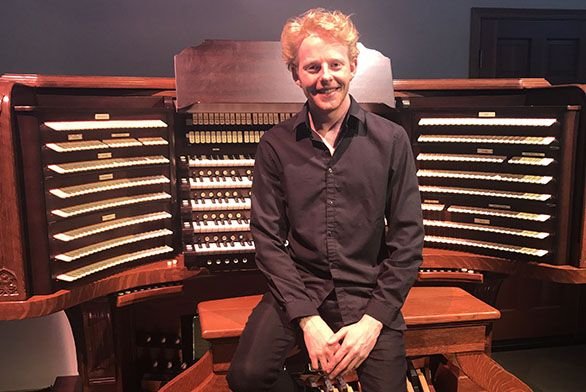Confronting Excellence
September 18, 2017 | By Eve Tolpa

Organist Eric Fricke (SF14) describes his musical approach as being a little off the beaten track.
“The way organ playing is done and taught today is based on an 18th- and 19th-century ideal of sonic possibilities,” he explains, adding that this style of academic playing holds no appeal for him.
Rather, he prefers the multiple combinations and complexities available to orchestras.
“If you take what a concert pianist is doing and apply that to several different keyboards—as well as one for the feet—that’s what I’m trying to do.”
Fricke currently explores those complexities in his job as principal organist at the Cathedral Basilica of St. Francis of Assisi in Santa Fe. His own style of playing fits the cathedral well given that its heritage encompasses a rich mix of styles and cultures.
“I know how to take some of the Spanish-style music that we use and adapt it to the organ.”
His background in musical theater helps keep services running smoothly.
“I look at it as a show or a production,” he says. “I just need to know my cue.”
Fricke spent his freshman and senior years at the Santa Fe campus, and there he began playing for the St. John’s choir. He also got involved in musical theater throughout the city, where he continues to teach in academic and theatrical capacities.
“My personal community kept me in town,” he says. “I didn’t have any real reason to leave. I have a wonderful life. It’s amazing what I can do as an artist—be a freelance musician and live on Canyon Road.”
During his sophomore and junior years in Annapolis, Fricke taught the freshman notation class. He fondly recalls Palestrina’s “Sicut Cervus,” an early polyphonic a cappella composition that can be performed by a group of eight people; during sophomore year, he set up a class in the Pendulum Pit and gathered students together to sing it. (See more about the St. John’s tradition of singing Sicut Cervus.) Later, during his professional life in Santa Fe, Fricke had the St. Michael’s High School choir perform that same piece, and it won the 2016-17 state championships.
Fricke viewed the sophomore music tutorial as an opportunity to witness other people’s discovery of music, asking himself, “How do I participate with people who don’t know what I know? What are the elements of music? How do you explain them? I had to look at my own biases and unravel them.”
For Fricke, who wrote his senior essay on Mozart’s “Don Giovanni,” there’s no question that St. John’s strengthened him as a musician. The processes of talking about and taking apart ideas is transferrable to his work, and he uses them when learning a new piece of music.
At the same time, implicit in the Program is a challenge.
“You have to find in yourself the kind of courage in one way, stamina in another, to be constantly confronted with excellence, to begin to recognize the elements of it,” he says, “so when you’re doing your own work, you can strive for it.”

